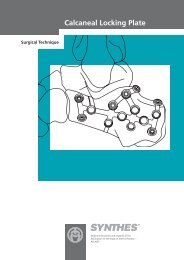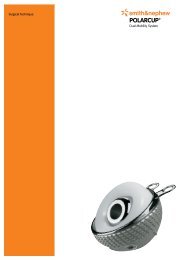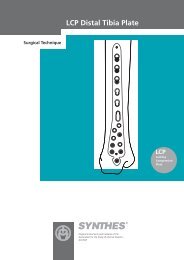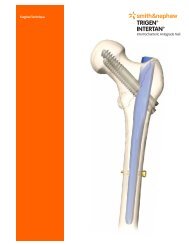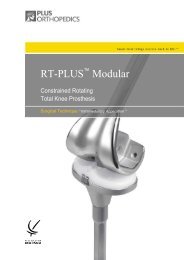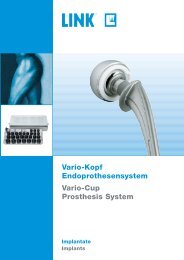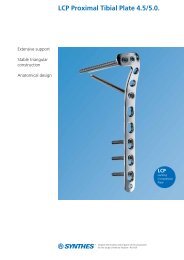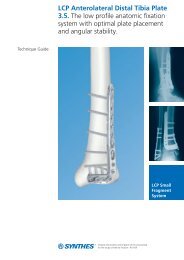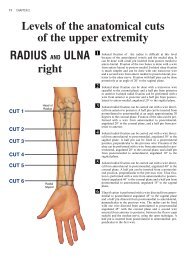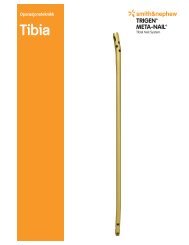Hoffmann II External Fixation System
Hoffmann II External Fixation System
Hoffmann II External Fixation System
Create successful ePaper yourself
Turn your PDF publications into a flip-book with our unique Google optimized e-Paper software.
Trauma<strong>Hoffmann</strong> <strong>II</strong><strong>External</strong> <strong>Fixation</strong> <strong>System</strong>Operative TechniqueModular <strong>System</strong> for• Long Bones• Pelvis
IntroductionIn 1938, Raoul <strong>Hoffmann</strong>, a surgeon from Geneva, Switzerland, designed arevolutionary <strong>External</strong> <strong>Fixation</strong> <strong>System</strong>. The basic features of this system wereits modular design and the ability to reduce fractures or to make post operativecorrections to the alignment of fragments in three planes with the frame in situ.The <strong>Hoffmann</strong> <strong>II</strong>® 1 has built upon these principles, and today is the goldstandard in modular external fixation. Certainly, the <strong>Hoffmann</strong> <strong>II</strong>® family ofproducts is unmatched in its ease-of-use, versatility, and patient comfort.You will find in the following pages common frame building techniques for the<strong>Hoffmann</strong> <strong>II</strong>® <strong>System</strong>.7.1. Pin to Rod Coupling8.9.10.2. Rod to Rod Coupling3. 5-Hole Pin Clamp4.1.2.4. Straight Post / 30° Angled Post5. Ø8mm Connecting Rods6. Semi-Circular AluminumConnecting Rods6.3.5.7. Dynamization Tube8. Compression/Distraction Tube9. Tube to Rod Coupling10. Apex® Self-Drilling Pins1<strong>Hoffmann</strong> <strong>II</strong>® Design SurgeonsDr. Gernot Asche,Andy Burgess M.D.,Prof. Franz Burny,Mr. Charles M. Court-Brown,Prof. Erkki O. Karaharju,Loren Latta Ph.D.,Prof. David Seligson M.D.,Dr. Gregory Zych M.D.2
Relative Indications & ContraindicationsRelative IndicationsDue to its versatility, the <strong>Hoffmann</strong><strong>II</strong>® <strong>System</strong> is indicated for completeand temporary fracture fixation forTibia, Femur, Pelvis, and Humerusfractures. It is particularly suited forthe following indications:• Open Fractures or Severe Soft-Tissue Injuries• Peri-Articular Fractures• Intra-Articular Fractures where ajoint bridging frame can be used• Temporary Fracture Stabilizationleading to definitive treatment• Poly-Trauma Patients• Other indications includingOsteotomies and ArthrodesisRelative ContraindicationsIf uncertainty exists with regardto the anatomic location of theneurovascular structures due to posttraumaticdestruction, the deviceshould be used with extreme caution.Under these circumstances, the pinsshould be inserted under direct vision.The presence of extensive internalfracture fixation devicesPre-emptive medical conditionBone Pathology3
Operative Technique1 51 10Frame Building GuidelinesThe guidelines given here will helpyou build frames which have beenproven to provide stability forsustained fracture reduction andelasticity for dynamic osteosynthesis.By using these simple biomechanicalprinciples, you can build a framesuited to the indication at hand.Pin clamps are designed to builda variety of frames. When using 2half-pins within a clamp, use thehole positions furthest apart if theanatomy and soft tissues allow. Thispin position is the most stable pin toclamp construct.Pin clamps and couplings shouldbe placed approximately 1.5 to 2.0centimeters away from the soft tissueto allow for post-operative swellingand proper pin-site care.> 1.5 to 2cmWhen tightening the clamps andcouplings, it is important to applysufficient torque to fully tighten theframe. It is also important to providesufficient counter torque so that thetightening of the frame does notdamage the pin/bone interface ordisturb the fracture site. Make sureto hold onto the clamp or coupling tobe tightened. This can be facilitatedby using the Stabilization/ReductionWrench as shown here.4
Operative TechniquePin Insertion GuidelinesFour types of half-pins are offered inthe system: Blunt/Self-Tapping Half-Pins, Blunt/Cancellous Half-Pins,Self-Drilling/Self-Tapping Half-Pins,and Self-Drilling Transfixing Pins.Predrilling is necessary when usingblunt pins. It is optional to pre-drillwhen using self-drilling pins.• Use a ø3.2mm drill to pre-drill aø4mm pin• Use a ø4.0mm drill to pre-drill aø5mm pin• Use a ø4.5mm drill to pre-drill aø6mm pin or a Cancellous Half-PinSelf-Drilling PinCancellous PinBlunt PinTransfixing PinIt is important to have a stable pin tobone interface. To ensure this, makesure to obtain bi-cortical purchasewith the pin.Due to the high versatility of the<strong>Hoffmann</strong> <strong>II</strong>® <strong>System</strong>, an unlimitednumber of frame configurationscan be constructed, thus providingsurgeons the ease of use to treat avariety of indications.This Technical Guide provides stepby step surgical techniques for fourstandard frame assemblies. Theseassemblies can then be adapted toother indications.Standard Bi-Lateral FrameProximal Tibia FramePelvic FrameAnkle Bridging Frame5
Operative TechniqueTibia Shaft FrameHalf-Pin Insertion GuidelinesThe safe zone of the tibia shaft is themedial side. For maximum bi-corticalbone purchase and patient comfort, itis suggested to insert pins 15° to 20°anterior to the coronal plane.Step 1The surgical technique utilizes alimited open approach for half-pininsertion. Make an incision at least2cm proximal to the fracture site.Using soft-tissue protection, manuallyinsert the first half-pin making sure toobtain bi-cortical purchase.Step 2Insert a second half-pin parallel to thefirst half-pin so that it will correspondto one of the holes in the clamp.6
Operative TechniqueTibia Shaft FrameStep 3Position the 5-Hole Pin Clampsapproximately 1.5 to 2.0 centimetersaway from the skin. Tighten Bolts Ato secure the clamps to the half-pins.Repeat Steps 1, 2 and 3 for the distalhalf-pin groups making an incision atleast 2cm distal to the fracture site.ABStep 4Assemble two <strong>Hoffmann</strong> <strong>II</strong>® Postswith each of the 5-Hole Pin Clamps.Tighten Bolts B to secure the posts.Note:The posts may be placed in twelvedifferent positions. It is also possibleto use straight or 90° posts. Thesepost options give flexibility to buildframe configurations as needed.Step 5Connect four Rod to Rod Couplingsto the posts and ø8mm ConnectingRods aligning the rods to the longaxis of the tibia. This will connectthe two 5-Hole Pin Clamps together.Unrestricted multi-planar motionof the components allows forthe manipulation of the fracturefragments with the fixator in place.7
Operative TechniqueTibia Shaft FrameStep 6After final adjustments andsatisfactory alignment have beenrestored, tighten Bolts C on the Rod toRod Couplings. Also, ensure that allof the bolts of the frame are securelytightened.For proper alignment, check the finalreduction with x-ray.C8
Operative TechniquemediallateralTibia Plateau FractureHalf-Pin Insertion GuidelinesFor this frame, 3 half-pins are insertedinto the metaphyseal region of theproximal tibia at least 1.5 centimetersdistal to the plateau under x-raycontrol. Also, 2 half-pins are insertedanterio-medially in the shaft of thetibia, approximately 90° to the longaxis of the bone. The safe zones areillustrated here.Step 1Using soft-tissue protection, manuallyinsert the medial and lateral halfpinsin the metaphyseal region of thetibia. Ensure that the half-pins do notcompromise the joint capsule.Step 2Connect a Pin to Rod Couplingto each half-pin, and connect thecouplings to a Curved Rod.9
Operative TechniqueTibia Plateau FractureStep 3Attach an Inverted Pin to RodCoupling to the anterio-medial aspectof the Curved Rod. Use this couplingas a guide for placing the anteriomedialhalf-pin.Note:In this frame, an Inverted Pin to RodCoupling is chosen due to its ease-ofuse.A standard Pin to Rod Couplingmay also be used if desired.Step 4Using soft-tissue protection, manuallyinsert the half-pin. Then, tighten thePin to Rod Couplings with Bolt A inorder to secure the Curved Rod to thehalf-pins.AStep 5At least 2cm distal to the fracturesite, assemble a half-pin/pin clampconstruct as shown here.10
Operative TechniqueTibia Plateau FractureStep 6Connect the two constructs using3 Connecting Rods, 5 Rod to RodCouplings, and 1 Pin to Rod Couplingas shown here. Unrestricted multiplanarmotion of the componentsallows for the manipulation of thefracture fragments with the fixator inplace.Step 7After final adjustments andsatisfactory alignment has beenrestored ensure that all Bolts aresecurely tightened. For properalignment, check the final reductionwith x-ray.Note:A half-pin may be added to the frameto capture a bone fragment or tofurther add stability.11
Operative TechniqueAnkle Stabilization FrameHalf-Pin Insertion GuidelinesThe safe zone for the tibia andcalcaneus is on the medial side.Take care not to damage soft tissue,particularly the posterior tibial arteryor tibial nerve.Step 1Using soft-tissue protection, inserttwo half-pins medially into thecalcaneus. Make sure to place thehalf-pins so that the completedframe is proximal to the base of thecalcaneus.Note:Insert the half-pins in clamp-holeposition 1 and 5 if the anatomypermits, since it will give the largestpin spread in the 5-Hole Pin Clampproviding maximum stability. Holes3 or 4 are also suitable if the anatomydoes not allow a hole-5 pin placement.1 3 4 5Step 2Insert two half-pins into the diaphysisof the tibia. Insert the pins medioanteriorly,approximately 15° to 20°anterior to the coronal plane.12
Operative TechniqueAnkle Stabilization FrameStep 3Position two 5-Hole Pin Clampsapproximately 1.5 to 2.0 centimetersaway from the skin. Tighten Bolts Ato secure the clamps to the half-pins.AStep 4Assemble a <strong>Hoffmann</strong> <strong>II</strong>® 30° Postto each of the 5-Hole Pin Clamps asillustrated. Tighten Bolts B to securethe posts.Note:Do not overtorque the Bolt B whichdoes not contain a post.BStep 5Connect a Rod to Rod Coupling toeach of the posts and a Pin to RodCoupling to the distal tibial half-pinand the anterior calcaneal half-pin.Connect two ø8mm Connecting Rodsto the couplings aligning the rods tothe long axis of the tibia. This willconnect the two 5-Hole Pin Clampstogether.13
Operative TechniqueAnkle Stabilization FrameStep 6After final adjustments andsatisfactory alignment have beenrestored, tighten Bolts C on the Rod toRod Couplings. Also, ensure that allof the bolts of the frame are securelytightened.CFor proper alignment, check the finalreduction with x-ray.The construct shown here is analternative ankle bridging frame. Twoø5mm half-pins are placed in the tibia,one ø5mm half-pin is placed in thecalcaneous, and one ø4mm half-pin isplaced in the 1st metatarsal.14
Operative TechniquePelvic FrameHalf-Pin Insertion GuidelinesThe pelvic frame described in thistechnique uses three half-pins placedin each iliac crest. The first half-pinshould be positioned 2.5cm posteriorto the Anterior Superior Iliac Spine.The second and third half-pins shouldbe inserted following the natural midlineof the iliac crest with a distanceof 1.5cm to 2.0cm between each of thepins.Take care to insert the pins betweenthe cortices of the iliac crest.Step 1Make a 1-2cm incision for eachpin over the iliac crest toward theumbilicus. Blunt dissect to the boneafter cutting through the skin.Using soft-tissue protection, manuallyinsert a half-pin between the innerand outer tables of the iliac cresttoward the acetabulum. After initialpenetration of the cortex, continueinserting the half-pin while takingcare not to penetrate the inner orouter tables.When using blunt pins, the outercortex of the Iliac crest must be predrilled.Step 2Place the second and third half-pins inthe same manner and check to ensureeach has adequate purchase. Repeatsteps 1 and 2 for the opposite side ofthe pelvis.15
Operative TechniquePelvic FrameStep 3Place a Pelvic Clamp over the threehalf-pins on each side of the pelvis.Tighten the clamps two to threefinger-breadths away from the skin.Step 4Connect four Rod to Rod Couplingsto the Pelvic Clamp Posts. From thisbase, build a "double cross bar" frameas shown here.Step 5While holding the reduced pelvis,properly adjust and stabilize the frameand fully tighten all bolts on the PelvicClamps and Rod to Rod Couplings.To verify alignment, obtain an APx-ray of the pelvis.The Frame is complete.16
Operative TechniquePelvic FrameThe construct shown below is analternative pelvic frame. Two halfpinsare placed in the supra-acetabularposition on each side of the pelvis.The half-pins should be insertedbetween the inferior and superior iliacspines with the first half-pin startingat the level of the anterior inferioriliac spine. This should be done inan open manner to avoid damage toneurovascular structures and underimage intensifier control to check thepin positions. The direction of thepins is in the sagital plane, and theyshould be angled slightly upwards (20degrees) to avoid penetration of theacetabulum.The second pin should be insertedproximal to the first one at a distancethat corresponds to the 3rd to the 5thpin position in the 5-Hole Pin Clamp.It is important to let the pins findtheir own way between the inner andouter tables of the ilium to obtaingood fixation.To verify alignment, obtain an X-Rayof the pelvis17
Ordering Information - ComponentsREFDescription<strong>Hoffmann</strong> <strong>II</strong>® Components4920-2-020 5-Hole Pin Clamp for Ø4, Ø5, and Ø6mm pins4920-2-060 10-Hole Pin Clamp for Ø4, Ø5, and Ø6mm pins4920-2-080 Pelvic Clamp for Ø4, Ø5, and Ø6mm pins4920-1-010 Rod to Rod Coupling for Ø8mm rods or posts4920-1-020 Pin to Rod Coupling for Ø4-5mm pins/Ø8mm rods or posts4920-1-030 Inverted Pin to Rod Coupling for Ø8mm rods or posts/Ø4-5mm pins4920-1-100 Tube to Rod Coupling for Ø20mm tubes/Ø8mm rods or posts4920-2-120 Straight Post Ø8mm4920-2-140 30° Angled Post Ø8mm4920-2-160 90° Angled Post Ø8mm18
Ordering Information - ComponentsREF Description Length mm<strong>Hoffmann</strong> <strong>II</strong>® Ø8mm Rods5029-8-805 Carbon Connecting Rod 655029-8-810 Carbon Connecting Rod 1005029-8-815 Carbon Connecting Rod 1505029-8-820 Carbon Connecting Rod 2005029-8-825 Carbon Connecting Rod 2505029-8-830 Carbon Connecting Rod 3005029-8-835 Carbon Connecting Rod 3505029-8-840 Carbon Connecting Rod 4005029-8-845 Carbon Connecting Rod 4505029-8-850 Carbon Connecting Rod 5005029-8-605 Aluminium Connecting Rod 655029-8-610 Aluminium Connecting Rod 1005029-8-615 Aluminium Connecting Rod 1505029-8-620 Aluminium Connecting Rod 2005029-8-625 Aluminium Connecting Rod 2505029-8-630 Aluminium Connecting Rod 3005029-8-635 Aluminium Connecting Rod 3505029-8-640 Aluminium Connecting Rod 4005029-8-645 Aluminium Connecting Rod 4505029-8-650 Aluminium Connecting Rod 5005029-8-065 Stainless Steel Connecting Rod 655029-8-100 Stainless Steel Connecting Rod 1005029-8-150 Stainless Steel Connecting Rod 1505029-8-200 Stainless Steel Connecting Rod 2005029-8-250 Stainless Steel Connecting Rod 2505029-8-300 Stainless Steel Connecting Rod 3005029-8-350 Stainless Steel Connecting Rod 3505029-8-400 Stainless Steel Connecting Rod 4005029-8-450 Stainless Steel Connecting Rod 4505029-8-500 Stainless Steel Connecting Rod 50019
Ordering Information - ComponentsREF Description Length mm<strong>Hoffmann</strong> <strong>II</strong>® ø8mm Curved Rods and ø20mm TubesL5029-7-028 Small Semi-Circular Curved Rod - Aluminium 134 (L)5029-7-030 Medium Semi-Circular Curved Rod - Aluminium 174 (L)5029-7-032 Large Semi-Circular Curved Rod - Aluminium 214 (L)4920-0-000 Dynamization Tube4920-0-015 Compression/Distraction Tube20
Ordering Information - InstrumentsREFDescription<strong>Hoffmann</strong> <strong>II</strong>® Instruments4920-9-010 Stabilization/Reduction Wrench4920-9-020 Thumbwheel4920-9-030 7mm T-Wrench/5, 6mm Pin Inserter5054-8-009 7mm Spanner Wrench4920-9-986 Storage Case Lid4920-9-985 Storage Case Upper Insert4920-9-984 Storage Case Lower Insert4920-9-983 Storage Case Base21
Notes22
Notes23
Joint ReplacementsTraumaSpineMicro ImplantsOrthobiologicsInstrumentsInterventional PainNavigationEndoscopyCommunicationsImagingPatient Handling EquipmentEMS EquipmentStryker Trauma AGBohnackerweg 1CH-2545 SelzachSwitzerlandwww.trauma.stryker.comThe information presented in this brochure is intended to demonstrate a Stryker product. Always refer to the packageinsert, product label and/or user instructions before using any Stryker product. Surgeons must always rely on theirown clinical judgement when deciding which products and techniques to use with their patients. Products may not beavailable in all markets. Product availability is subject to the regulatory or medical practices that govern individualmarkets. Please contact your Stryker representative if you have questions about the availability of Stryker productsin your area.Products referenced with designation are trademarks of Stryker.Products referenced with ® designation are registered trademarks of Stryker.Literature Number: 5075-1-001LOT B2205Copyright © 2005 StrykerPrinted in Germany



